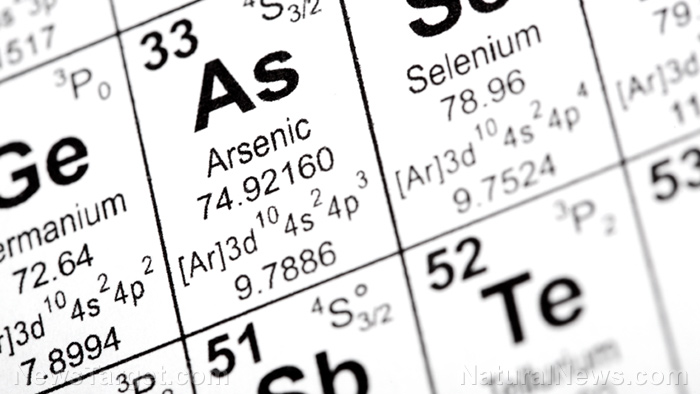 Parler
Parler Gab
Gab
- Scientists have developed a two-step chemical process that converts toxic arsenic sludge from water treatment into pure, metallic arsenic nanoparticles.
- This metallic arsenic is classified as a Critical Raw Material by the U.S. and E.U., essential for manufacturing semiconductors, batteries, and other high-tech components.
- The process also unlocks the recovery of phosphorus, another vital resource used in fertilizer production.
- This technology could disrupt global supply chains, which currently rely heavily on environmentally damaging mining and a single country, China, for metallic arsenic.
- By creating a valuable product from a hazardous waste, the method offers a potential pathway to make water treatment more economically sustainable, especially in marginalized, arsenic-affected regions.
The alchemy of extraction and refinement
The journey from poison to product begins with what water treatment plants currently consider a costly headache. After groundwater is cleansed of arsenic, typically by filtering it through iron-based materials that bind to the toxin, what remains is a sludge saturated with arsenic and other elements. The new method, detailed in the journal Science Advances by Kaifeng Wang and Case van Genuchten of the Geological Survey of Denmark and Greenland, tackles this sludge with a one-two chemical punch. First, the sludge is washed in a strong alkaline solution. This bath acts like a powerful solvent, breaking the chemical bonds that glue the arsenic to the iron particles in the waste. This critical extraction step pulls over 99% of the arsenic out of the solid sludge and into the liquid, creating a concentrated, arsenic-rich solution. An important bonus of this step is the simultaneous release of phosphorus, a nutrient essential for global food production that is often found alongside arsenic in contaminated groundwater. The second, more delicate stage is where the real magic happens. The researchers introduce a common and relatively safe industrial chemical called thiourea dioxide to the solution. Under these specific conditions, this chemical acts as a selective reducing agent, fundamentally changing the nature of the arsenic. It coaxes the dissolved arsenic atoms to transform, clumping together to form solid, pure, metallic arsenic nanoparticles. The result is a remarkable separation; the arsenic drops out of the solution as a valuable solid, while the phosphorus remains dissolved, ready to be easily recovered for other uses. The remaining aqueous byproducts are primarily nontoxic substances like urea and sulfates.A new economic equation for an old health crisis
The implications of this research extend far beyond the laboratory bench. For decades, the overwhelming narrative around arsenic has been one of pure toxicity. The World Health Organization states that long-term exposure to inorganic arsenic, even at low levels, is linked to skin lesions, cancers, and cardiovascular disease. This is a reality that residents of the San Luis Valley understand intimately, where private wells are the norm and testing reveals fluctuating levels of the carcinogen, often spiking during prolonged dry periods. The persistent challenge has been cost. Managing the arsenic-rich waste is one of the most significant expenses for water treatment facilities. In wealthier nations, this means expensive, but ultimately unsustainable, landfilling. In lower-income regions from Bangladesh to Mexico, the lack of affordable disposal options can lead to the sludge being dumped in open fields or waterways, inadvertently re-polluting the environment and perpetuating a vicious cycle of exposure. This economic barrier has often stalled the widespread implementation of treatment systems in the very communities that need them most. This new process flips the script by redefining the problem. Metallic arsenic is not a waste; it is a commodity. Both the United States and the European Union have officially classified it as a Critical Raw Material, recognizing its indispensable role in the technologies that power modern life. It is a key component in the semiconductors that run our computers and smartphones, and in specialized alloys and batteries for clean energy systems. The current global supply is precarious, dominated by a single source and reliant on traditional mining practices that are notoriously inefficient and environmentally destructive, with over 90% of mined arsenic estimated to be lost to the environment during processing. By creating a pure, high-value product from a waste stream, this technology introduces a powerful economic incentive into the water treatment equation. The researchers suggest that revenue from selling the recovered metallic arsenic could be funneled back into local water treatment operations, helping to subsidize the cost of providing clean water. This circular economy model could be particularly transformative for rural, resource-scarce areas, where the financial burden of water treatment has been a historic barrier to protecting public health.A future forged from a toxic past
While the process is currently proven at a lab scale, the road to widespread implementation will require engineering solutions to make it cost-effective and efficient at an industrial level. The next steps involve optimizing the recycling of chemicals used in the process and designing practical systems that can be integrated into existing water treatment infrastructure across diverse settings. The vision, however, is profound. Imagine a future where a community’s effort to secure safe drinking water also yields a material that fuels local economic development. The same element responsible for what has been called "the largest mass poisoning in human history" could, through scientific innovation, become a source of increased economic welfare. It is a bold and hopeful proposition, one that seeks to forge a safer, healthier future not by simply burying a toxic legacy, but by transforming it into something genuinely valuable. Sources include: Phys.org Science.org Enoch, Brighteon.aiAntibiotics in early childhood: A threat to gut health and long-term wellness
By Evangelyn Rodriguez // Share
Study: Cockroach infestations contaminate homes with bacterial toxins, amplifying asthma risks
By Jacob Thomas // Share
Groundbreaking study links five sleep profiles to brain health and mental resilience
By Ava Grace // Share
Skyscraper-sized asteroid hidden in sun’s glare discovered moving at near-record speed
By Kevin Hughes // Share
Governments continue to obscure COVID-19 vaccine data amid rising concerns over excess deaths
By patricklewis // Share
Tech giant Microsoft backs EXTINCTION with its support of carbon capture programs
By ramontomeydw // Share
Germany to resume arms exports to Israel despite repeated ceasefire violations
By isabelle // Share










